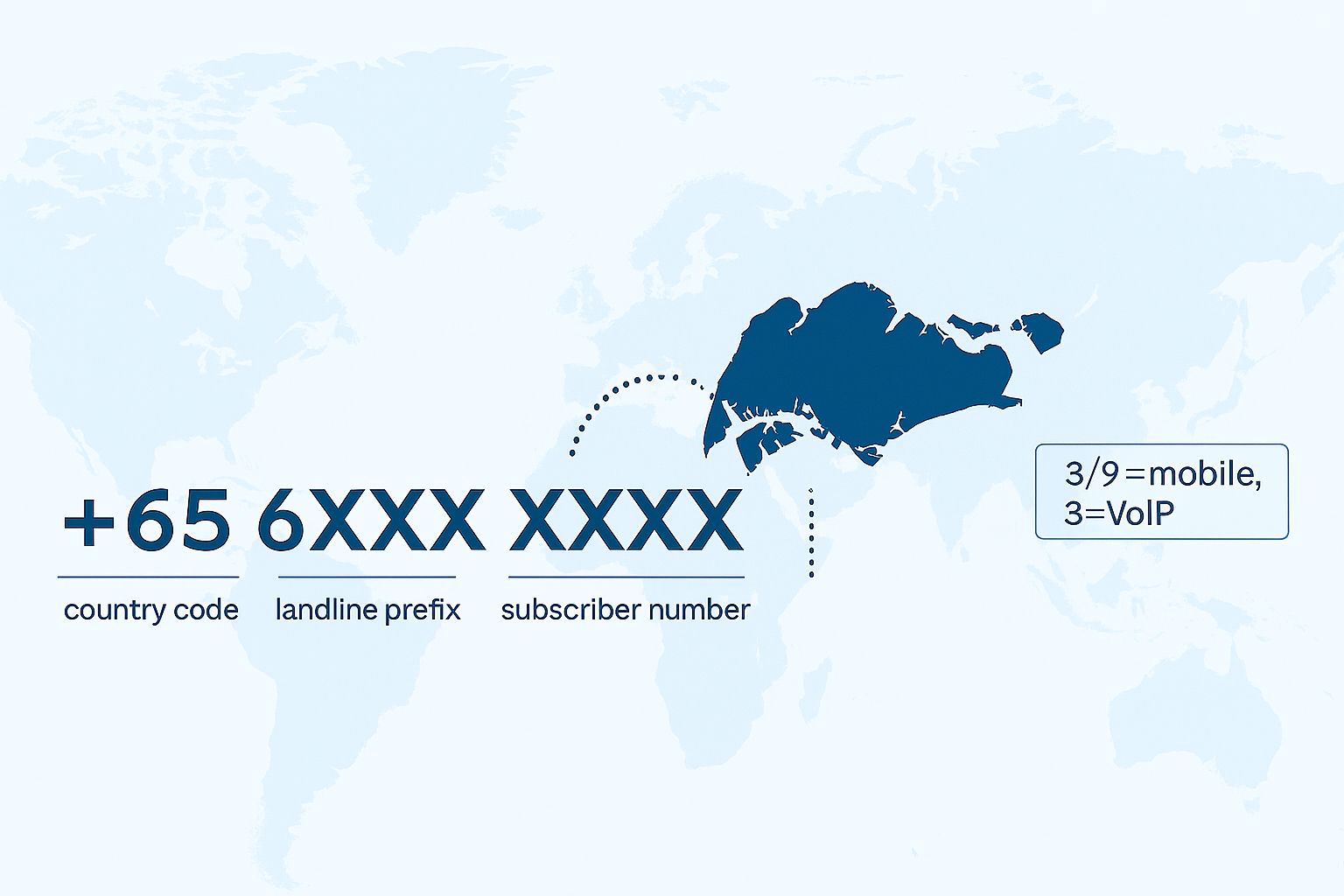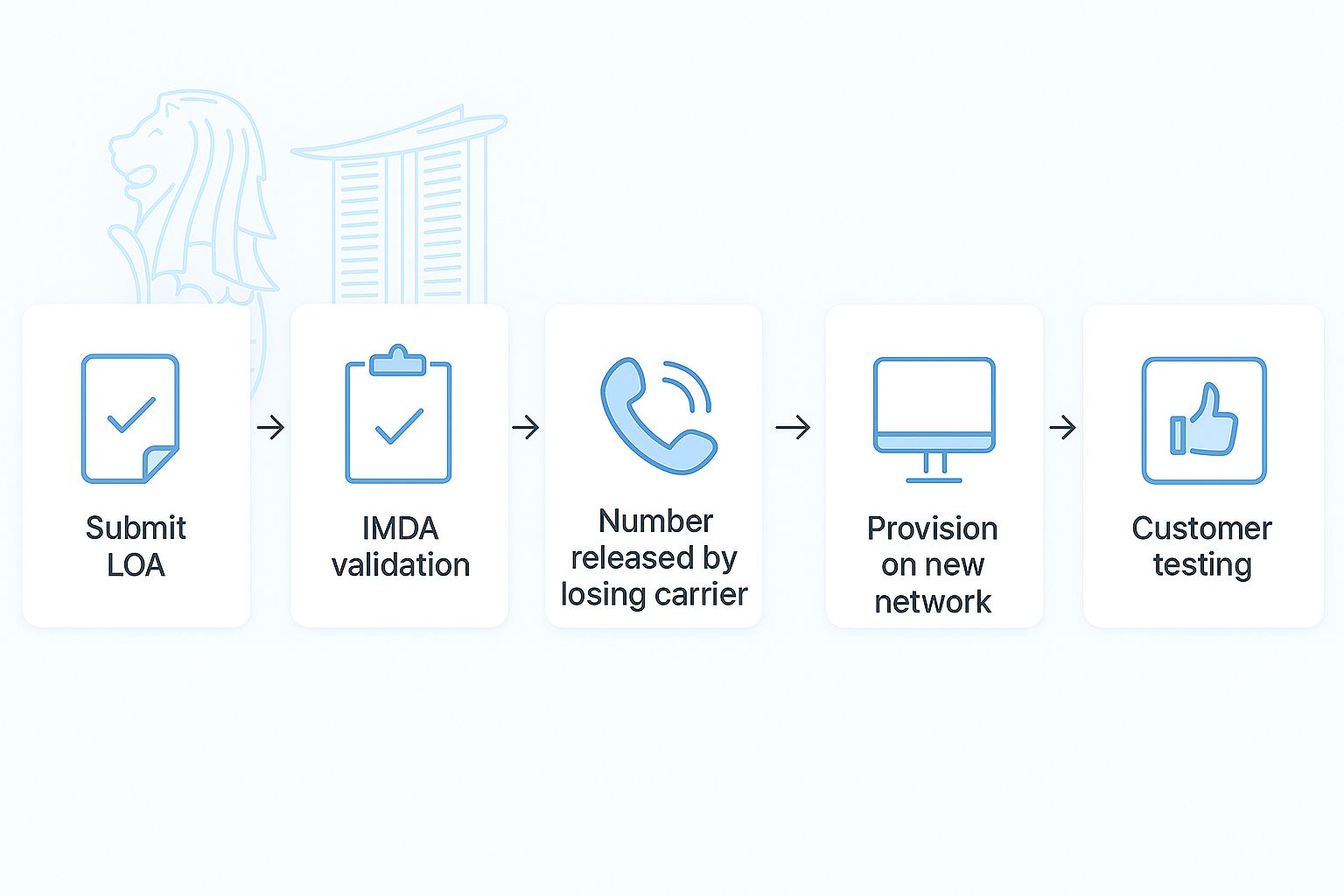Key Takeaway
- Use your country’s international exit code + (on mobiles, long-press 0) or the numeric exit code (e.g., 011 from the U.S.), then 65, then the 8-digit subscriber number.
- Examples:
- Mobile or landline in Singapore
6123 4567→ dial +65 6123 4567 (or 011 65 6123 4567 from the U.S.).
- Mobile or landline in Singapore
- Anti-scam note: Singapore telcos and IMDA have implemented measures to help block or label suspicious international calls (including options for subscribers to block international incoming calls). If a Singapore number doesn’t connect or shows a
+65flag unexpectedly, check IMDA guidance or contact your telco before calling back.
Why do Singapore landline numbers look so… short?
Singapore uses a closed eight-digit plan with no regional area codes. The entire island is one numbering area, so every fixed-line starts with 6 and runs eight digits straight after the +65 country code. That’s it. No hidden prefixes, no parentheses juggling.
What the leading digit means
Singapore numbers are 8 digits and the first digit indicates the service type. Per IMDA:
- 3xxxxxxx — IP telephony / business & corporate VoIP lines.
- 6xxxxxxx — Fixed (PSTN) and residential IP telephony (this is what most landlines use).
- 8xxxxxxx / 9yxxxxxx — Mobile and other mobile/data services (8 and 9 series).
There are no geographic area codes — every number is eight digits and belongs to Singapore’s single numbering area. (Source: IMDA National Numbering Plan).
What makes landlines worth the hassle in a mobile first world?
- A landline still signals permanence and trust
- Many Singapore B2B customers list only fixed numbers on vendor forms
- Some finance and health-care workflows require a registered PSTN line for KYC or compliance
And true story international call surcharges on mobiles can be higher than on fixed routes, so having a landline can save both you and your callers money.

How to dial a Singapore landline from the ten most asked countries
| Calling from | Exit code | Full dial string |
|---|---|---|
| United States | 011 | 011 65 6 ### #### |
| United Kingdom | 00 | 00 65 6 ### #### |
| Australia | 0011 | 0011 65 6 ### #### |
| India | 00 | 00 65 6 ### #### |
| Germany | 00 | 00 65 6 ### #### |
| Canada | 011 | 011 65 6 ### #### |
| Malaysia | 00 | 00 65 6 ### #### |
| Japan | 010 | 010 65 6 ### #### |
| UAE | 00 | 00 65 6 ### #### |
| Brazil | 00 or 0014* | 00 65 6 ### #### |
*Brazilian carriers vary; check your provider. Notice the pattern? Exit code → +65 → 8-digit landline. Skip leading zeros (Singapore numbers never start with 0). Source cross-checked with international dialling rules and country-code directories.
So you need your own Singapore landline here’s the roadmap
1. Decide on on-prem vs. virtual.
Traditional telcos (Singtel, StarHub, M1) wire copper or fibre to your office. Virtual operators ride on IP and give you a DID you can answer anywhere. Both draw their numbers from the same IMDA pool; only the delivery changes.
2. Check the IMDA licence list.
Singapore’s regulator publishes which Fixed-Services or IP Telephony licensees are allowed to allocate ‘6’ numbers. Sticking with that list keeps you compliant from day one.
3. Gather your paperwork.
ACRA business profile (for companies), NRIC or passport (for individuals), local contact address, and a basic service-use declaration. No shady shell entities IMDA vets number assignments to fight scam calls.
4. Submit your application.
For physical lines, the telco schedules a technician. For virtual DIDs, you’ll likely email scanned documents, pay the setup fee, and receive activation within 24–72 hours.
5. Test inbound and outbound.
Ring the line from abroad and from a local mobile. Confirm caller-ID shows “+65 6…” exactly as advertised.
6. Set up fail-over.
Power outage? Flooded comms room? Forward unanswered calls to a mobile after X rings so customers never hit dead air.
What if you already own a Singapore landline and want to port it?
Good news: Singapore adopted number portability back in 2006. The steps:
1. Request a Letter of Authorisation (LOA) from the gaining provider.
2. Fill in porting details current telco, number block, desired cut-over date.
3. Await IMDA clearance (usually 5–7 working days).
4. Test during the cut-over window; some trunks will drop for 30–90 minutes.
5. Verify billing closure with the losing provider.
Note: Schedule porting after business hours if voice traffic is mission-critical.

Reverse lookup & validation tools
| Tool | What it does | Cost |
|---|---|---|
| IMDA Check Caller ID hotline | Confirms if a ‘+65 6’ number is allocated or spoofed | Free |
| SG-Whois XML feed | API returns allocation block and carrier | Freemium |
| NTU ScamCall Database | Community reported suspicious numbers | Free |
| Global CNAM API | Fetches name display for Singapore DIDs | Paid |
Always cross-reference at least two sources before blacklisting a number spoofing is rampant.
Compliance & best practice checklist
| Item | Why it matters |
|---|---|
| PDPA consent logging | You must record opt-ins if you’ll dial customers regularly. |
| Do-Not-Call Registry scrubbing | Fines can hit SGD 10,000 per offence. |
| Display valid caller ID | IMDA mandates accurate CLI to curb scams. |
| Store CDRs for 6 months | Helps in dispute resolution and fraud tracing. |
a reputable managed voice provider should automate most of this, but the legal liability stays with you, not them.
Troubleshooting your new ‘+65-6’ line
- “I’m dialling 65 6 ### #### from abroad but get a fast busy tone.” Double-check you added your country’s exit code first. In the U.S. that’s 011; in the U.K. 00.
- “Caller ID shows 065 instead of +65.” Your PBX is adding a leading zero. Strip it Singapore numbers never start with 0.
- “Local mobiles can’t reach my landline.” Ask the carrier to confirm routing tables; sometimes new number blocks take 24 hours to propagate.
FAQs
1. Can two businesses share one Singapore landline?
Yes, via hunt groups or IVR, but IMDA requires a single “responsible legal entity” on record.
2. Are toll-free 1800 numbers the same as landlines?
Not quite. 1800 can map internally to a ‘6’ line, but billing rules differ.
3. Is there an area code for Jurong or Sentosa?
Nope one island, one code. All geo distinction comes after the call lands.
4. What prefix do virtual VoIP numbers use?
Usually ‘3’, although some providers now issue ‘6’ if they meet stricter QoS rules.
5. How long does porting really take?
Five business days end-to-end is typical if paperwork is clean.
6. Can I forward a Singapore landline to a U.K. mobile?
Absolutely just expect two-leg billing (Singapore leg + U.K. leg) unless your plan bundles forwarding.
Before you go… a smarter way to handle those calls 📞
Setting up a landline is only the first step. If you’d like every inbound ring to be answered within one second 24×7 in natural, conversational English and Mandarin, check out
Make a browser test call to any Singapore number via SuperU.


